Digitalization and the increasing prevalence of remote work boost the rise of IT outsourcing, especially in manufacturing, finance, and e-commerce industries. Primarily, due to a scarcity of IT experts, businesses typically seek to delegate tech tasks to offshore or nearshore teams. The shortage is associated with the high demand for experts. For example, the employment of software developers and QA engineers is expected to increase by 25 percent by 2032.
The IT outsourcing sector has experienced consistent growth in recent years due to an increasing demand for products and services that require technical skills. This decreases the threshold for outsourcing tech tasks to companies abroad. Outsourcing IT tasks allows businesses to focus on their core operations, save the budget, and allocate internal resources more effectively. Outsourcing is a cost-effective strategy that allows companies to keep up to their quality and security standards.
Outsourcing development companies in Ukraine are known for their highly skilled and competent tech experts. Ukraine has become a popular outsourcing destination known for competent tech experts. Roughly speaking, the number of IT companies in Ukraine is approximately 2,100-2,300, with nearly half of Ukrainian AI specialists living in Kyiv. A significant number of specialists are allocated in Lviv (18%), Dnipro (6%), Odesa (4%), and Kharkiv (4%). Overall, IT has grown into Ukraine’s second-largest export industry, accounting for approximately 37–42% of service exports and 11–13% of total exports of goods and services. Thus, businesses continue investing in the Ukrainian IT market, which is constantly growing.
In this article, we will cover why IT outsourcing to Ukraine is a strategic step for your business. You will also learn how Ukrainian experts can help with your project, find the best Ukraine IT outsourcing companies to choose from, and discover how to efficiently communicate with an external team.

Best IT outsourcing companies in Ukraine
| Company | Founded | Locations | Number of employees | Expertise |
|---|---|---|---|---|
| Lemberg Solutions | 2007 | Lviv, Lutsk, Rivne (Ukraine), Hamburg (Germany), London (the UK), Krakow (Poland) | 200+ | Digital Experiences/ Cloud & DevOps/ Embedded Development/ Data Science & AI |
| DataArt | 1997 | Lviv, Kyiv (Ukraine), Dallas, New York (the USA), London (the UK), Dubai (the UAE), Munich (Germany), Zug (Switzerland) | 2000+ | AI, ML & Data Analytics/ Cloud migration & DevOps/ Custom software engineering |
| Ciklum | 2002 | Lviv, Kyiv (Ukraine), London (the UK), Wrocław, Gdansk (Poland) & offices in South Asia and Middle East | 2000+ | Product & Platform engineering/ IoT development/ ML, AI & BI in Production |
| Miratech | 1989 | Kyiv (Ukraine), New York (the USA) Warsaw (Poland) & offices in South America and South Asia | 800+ | Cloud migration/ AI & Machine learning/ Big data analytics |
| ELEKS | 1991 | Lviv, Kyiv (Ukraine), Chicago (the USA), Tallinn (Estonia), Tokyo (Japan), AI Jubail (Saudi Arabia) | 1000+ | App development/ Product design/ Cloud migration |
| Sigma Software | 2002 | Kyiv, Lviv (Ukraine), Warsaw, Krakow (Poland) & offices in North and South America, Middle East and Southeast Asia | 1500+ | Embedded & IoT/ Cloud & DevOps/ Website development/ |
| inVerita | 2015 | Lviv (Ukraine), Sacramento (the USA), Krakow (Poland) | 100+ | Cloud & DevOps/ Mobile & Web app development/ Digital product design/ |
| Luxoft | 2000 | Kyiv, Dnipro (Ukraine), London (the UK), NYC (the USA) & offices in the Western Europe and Asia Pacific | 1500+ | Cloud solutions/ Data analytics & ML/ Design/ |
| SoftServe | 1993 | Lviv (Ukraine), Warsaw, Krakow (Poland) London (the UK) & offices in the North and South Americas, the Middle East and the Southeast Asia | 1500+ | IoT & Robotics/ Cloud & DevOps/ AI & ML/ |
| GlobalLogic | 2000 | Kyiv, Lviv (Ukraine), Charlotte (the USA) Toronto (Canada) & the offices in the Western Europe, Middle East and South America | 1500+ | Software engineering/ Cloud adoption/ Data & analytics |
| Kindgeek | 2015 | Lviv (Ukraine), London (the UK) | 200+ | Web & mobile development/ Business analysis/ UI/UX design |
| EPAM | 1993 | Kyiv, Lviv (Ukraine), London (the UK) & more offices in North and South Americas, Western and Central Europe, and APAC region | 10,000+ | GenAI & Data analytics/ Cloud & DevOps/ Cybersecurity |
| N-IX | 2002 | Lviv, Kyiv (Ukraine), Florida (the USA), Medellin (Colombia) London (the UK) & offices in Western Europe | 2000+ | Software engineering/ Cloud solutions / AI, ML & Data Science |
| TechMagic | 2014 | Lviv (Ukraine), Krakow (Poland) London (the UK) | 320+ | Web & Mobile development/ Data engineering/ Cloud implementation |
| Reenbit | 2018 | Lviv (Ukraine), Ontario (Canada), Warsaw (Poland) | 60+ | Custom software development/ Mobile app development/ Cloud engineering |
| Edvantis | 2005 | Lviv (Ukraine), New York (the USA) Rzeszow (Poland), Berlin (Germany) | 400+ | Software engineering/ Data Science, BI & AI/ Cloud development |
| 8allocate | 2015 | Kyiv (Ukraine) Tallinn (Estonia) & offices in CEE region and LATAM | 100+ | Digital product development/ AI/ML implementation/ Cybersecurity & risk management |
| Sombra | 2013 | Lviv, Kyiv (Ukraine), Medellin (Colombia) | 300+ | Software consulting/ Custom software development/ Data engineering |
| Yalantis | 2008 | Lviv, Kyiv, Dnipro (Ukraine), Warsaw (Poland), Tallinn (Estonia), Larnaca (Cyprus) | 500+ | Custom software development / IT consulting/ Digital transformation |
| Binariks | 2014 | Lviv (Ukraine), Katowice (Poland), Torrance (the USA) | 180+ | Software product development/ AWS consulting/ Data Science, AI & ML |
| Noltic | 2017 | Lviv (Ukraine) Warsaw (Poland) | 70+ | Salesforce integration/ Salesforce app development/ UI/UX design |
| Mind Studios | 2013 | Dnipro (Ukraine) | 75+ | Custom software development/ Software re-engineering/ BA & IT consulting |
| Avenga | 2019 | Lviv (Ukraine), Rochelle Park (the USA), Warsaw (Poland), Berlin (Germany) Kuala Lumpur (Malaysia) | 7000+ | Custom software development/ Mobile & Web development/ UI/UX |
| Exoft | 2013 | Lviv (Ukraine) | 70+ | Web & Mobile development/ UI/UX design/ QA services |
| Binary Studio | 2005 | Lviv (Ukraine) Winchester (the UK) Dubai (the UAE) | 140+ | MVP software development/ CRM software development/ SaaS app development |
| Uptech | 2016 | Kyiv (Ukraine), Tallinn (Estonia), Paphos (Cyprus) | 90+ | Web & Mobile app development/ GenAI development/ UI/UX design |
| IT Svit | 2005 | Tallinn (Estonia) Lviv, Kharkiv (Ukraine) | 70+ | DevOps services/ Cloud computing/ Server support |
We’ve prepared a list of the top IT outsourcing companies in Ukraine to help you choose the vendor that meets your needs. Note that this list is not a ranking and serves solely to help you find a tech partner for your project.
Lemberg Solutions


- Founded: 2007
- Employees: 200+
- Hourly rate: $50 - $99
- Locations: Ukraine, Germany, Poland, the UK.
- Key clients: UNDP, Caltech, Syngenta Group, European Commission, Voltfang, German Autolabs
Lemberg Solutions is a tech consulting and software engineering company, based in Lviv, Rivne, and Lutsk, and has a German office in Hamburg to serve European clients more conveniently. In 15 years, the company has grown to 200+ specialists with expertise in data science and AI, embedded development, cloud and DevOps, and digital experiences. In 2022, GoodFirms recognized Lemberg Solutions as the best company to work with. Moreover, in 2023, Lemberg Solutions won Splash Awards Switzerland in the International Businesses category.
The company offers flexible cooperation scenarios, including solution discovery, tech consulting, end-to-end development, team extension, and support and maintenance. Lemberg Solutions takes care of their clients’ data privacy and solution quality. That’s why they received ISO 9001:2015 and ISO 27001:2013 certifications for quality management and security policies and ISO 13485:2016 certification that proves they provide medical software and hardware solutions that comply with international healthcare regulations.
Their engineers have hands-on experience in various industries, including healthcare, automotive, energy, agritech, consumer electronics, industrial IoT, transportation and logistics, and many more. In addition to hardware development, this Ukrainian software outsourcing company provides wide service expertise:
- Digital experiences
- Cloud & DevOps
- Embedded development
- Data science & AI
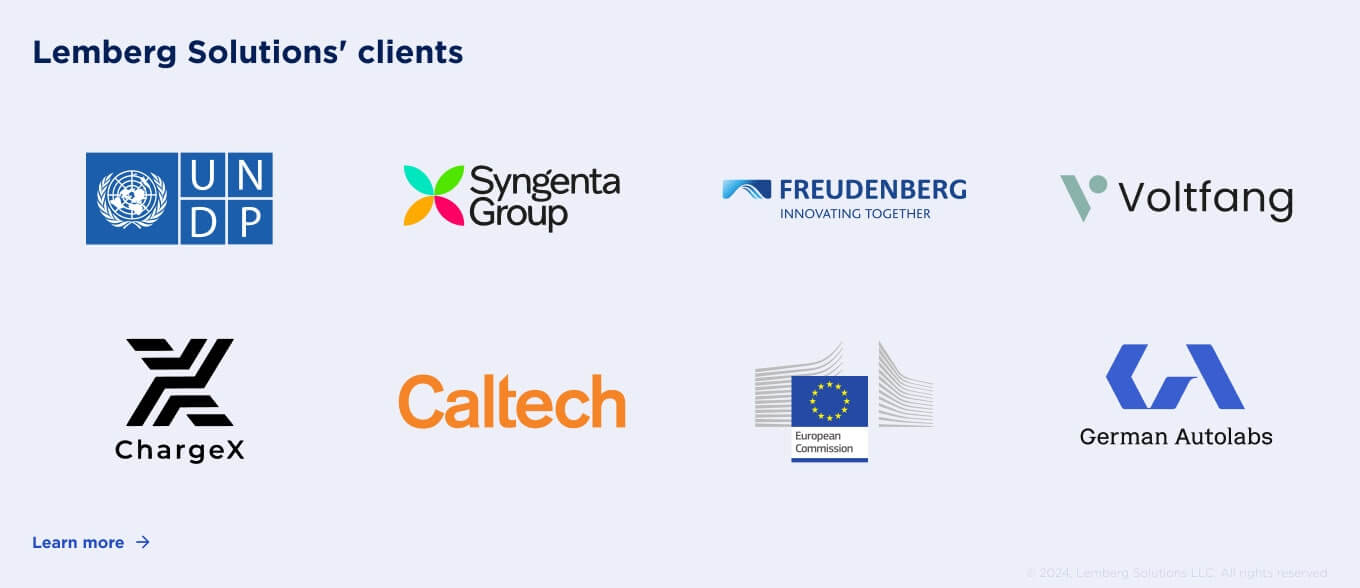
When working with our clients, we prioritize building long-term relationships, supporting them at every stage of the development process — from solution discovery, design and development to ongoing support after the product is launched.
DataArt
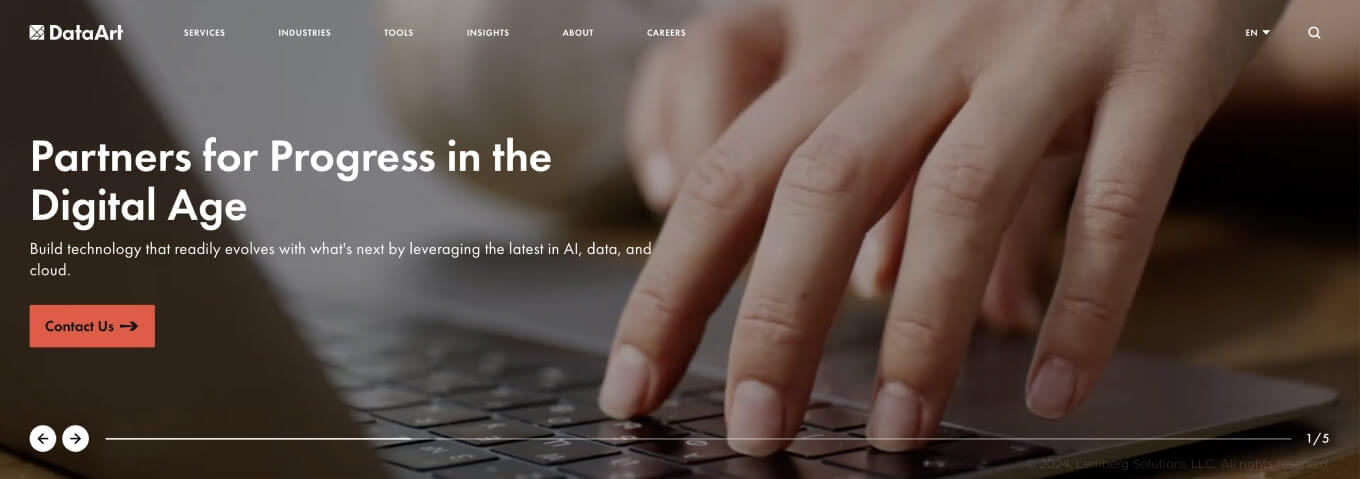

- Founded: 1997
- Employees: 2000+
- Hourly rate: $50 - $99
- Locations: Ukraine, Germany, Switzerland, the UAE, the UK, the USA
- Key clients: Ocado Technology, Metro Markets, NASDAQ, Skyscanner
DataArt has several offices in Ukraine, the U.S., and across Europe. The company has 2400 specialists who develop custom software solutions and help clients grow their business. Throughout more than 20 years on the market, DataArt accumulated experience in different industries, such as travel, finance, media and entertainment, education, and healthcare. Their team assists clients with the following services:
- AI and ML, Data & Analytics
- Cloud migration & DevOps
- Custom software engineering
Ciklum


- Founded: 2002
- Employees: 2000+
- Hourly rate: $50 - $99
- Locations: Ukraine, the UK, Poland & offices in South Asia and the Middle East
- Key clients: TUI Group, Panasonic, Etoro, Betsson
Ciklum has been on the market since 2002 and extended their offices all over Ukraine, UK, and Europe. The company has more than 2400 employees in Ukraine and provides custom engineering services for banking, financial services and insurance (BFSI), consumer goods, and iGaming industries. The company helps their clients thrive in connectivity by ensuring seamless consumer electronics and enabling transformation. Here are the services the company offers:
- Product & platform engineering
- IoT development
- ML, AI & BI in Production
Miratech
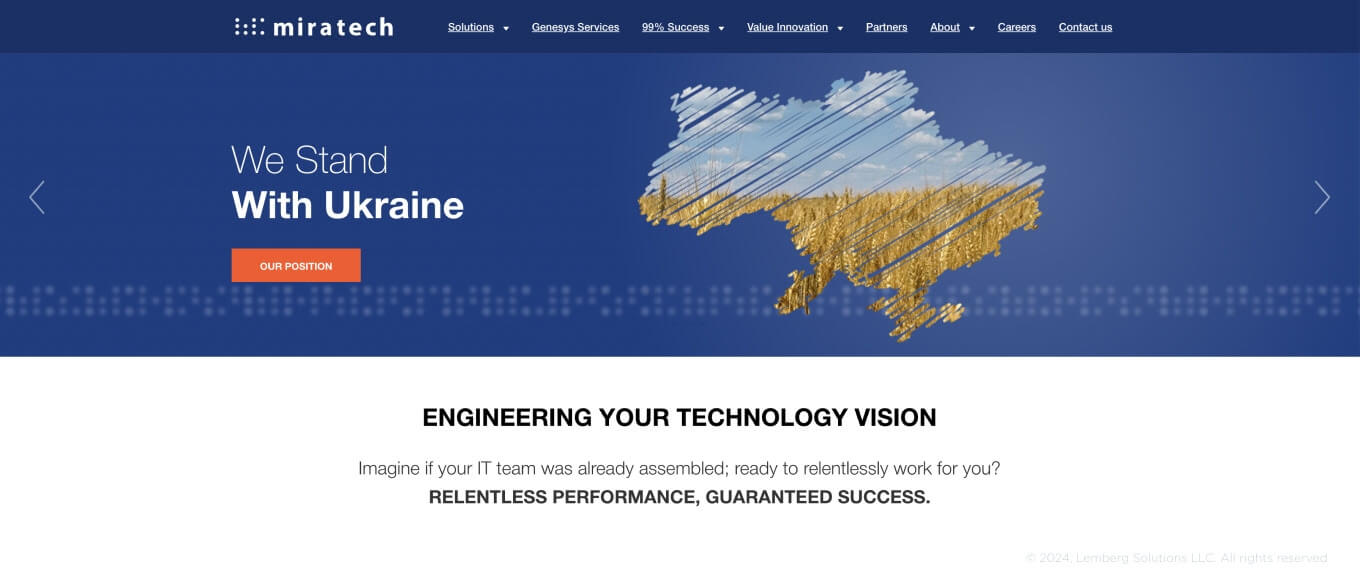

- Founded: 1989
- Employees: 800+
- Locations: Ukraine, the USA, Poland & offices in South America and the South Asia
- Key clients: Aptic, IBM, OTP Bank, Raiffeisen Bank
Since 1989 Miratech has increased its employees number to more than 800. They have offices in Cyprus, Poland, Slovakia, Spain, Turkey, Ukraine, and the U.S. Miratech provides clients with cloud, AI, ML, big data, blockchain, and team extension services in the fintech, insurance, telecommunications, and healthcare industries. Their expertise also covers cybersecurity, including security assessments and regulatory compliance. Here are the services Miratech provides:
- Cloud migration
- AI & Machine learning
- Big data analytics
ELEKS


- Founded: 1991
- Employees: 1000+
- Hourly rate: $50 - $99
- Locations: Ukraine, the USA, Estonia, Japan and Saudi Arabia
- Key clients: Aramex, GRTGaz, ESET, DPD
ELEKS has operated since 1991 and unites a wide range of professionals, having more than 1400 employees in Ukrainian offices. In addition to Ukraine, ELEKS has offices in Europe, the USA, Canada, Japan, and Saudi Arabia. The company’s services encompass such industries as logistics, automotive, retail, agriculture, media, fintech, and more. Within these industries, ELEKS provides help with:
- App development
- Product design
- Cloud migration
Sigma Software
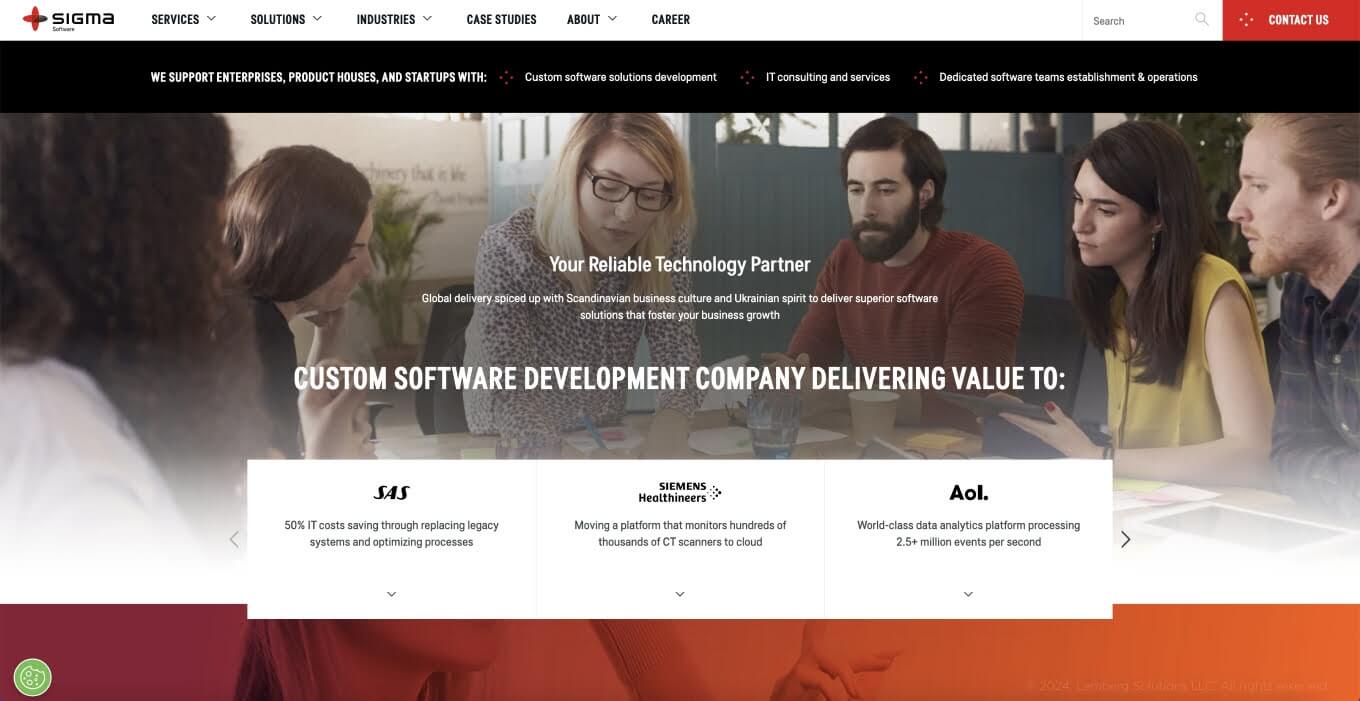

- Founded: 2002
- Employees: 1500+
- Hourly rate: $50 - $99
- Locations: Ukraine, Poland & offices in North and South America, the Middle East, and Southeast Asia
- Key clients: AstraZeneca, IATA, IGT, SAS
Sigma Software has operated for over 20 years and gained great reputation among their clients. The company has more than 1500 employees in Ukrainian offices and has offices around the rest of the world. With Sigma Software, clients from the automotive, aviation, real estate, gaming, media, and other industries can receive technical support and turnkey software solutions. Businesses cooperate with Sigma Software for the following services:
- Embedded & IoT
- Cloud & DevOps
- Website development
inVerita
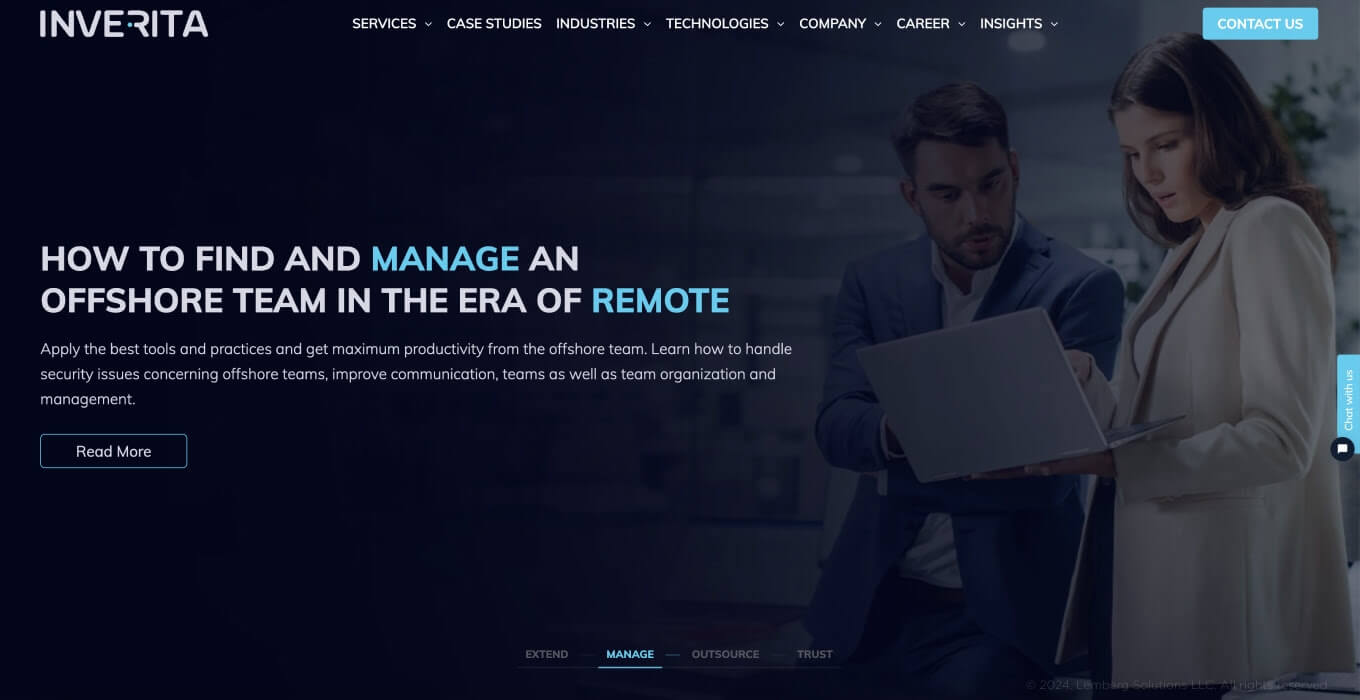

- Founded: 2015
- Employees: 100+
- Hourly rate: $50 - $99
- Locations: Ukraine, the USA, Poland
- Key clients: IntelliBoard, MediaShout, Fit Gift, QAD
inVerita was founded in 2015 and gained the trust of numerous clients ever since. The company uses cutting-edge technologies to help their clients stay ahead of the competition. With over a 100 employees on board, inVerita helps different organizations create new digital products. They operate within the healthcare, fintech, logistics, retail, real estate, and e-learning industries. The company offers a wide range of services, including:
- Cloud & DevOps
- Mobile & web app development
- Digital product design
Luxoft


- Founded: 2000
- Employees: 1500+
- Hourly rate: $100 - $149
- Locations: Ukraine, the UK, the USA & offices in Western Europe and the Asia Pacific
- Key clients: MOTER, Philips Sonicare, ReachNow, Blue Nile
Since 2000, Luxoft has been providing innovative solutions to clients from all over the world. They have more than 1500 employees in Ukrainian offices, as well as other professionals working from South America, Europe, and the UK. Luxoft serves clients from the automotive, banking, consumer goods, energy, healthcare, and other industries, providing diverse services, including:
- Cloud solutions
- Data analytics & ML
- Design
SoftServe
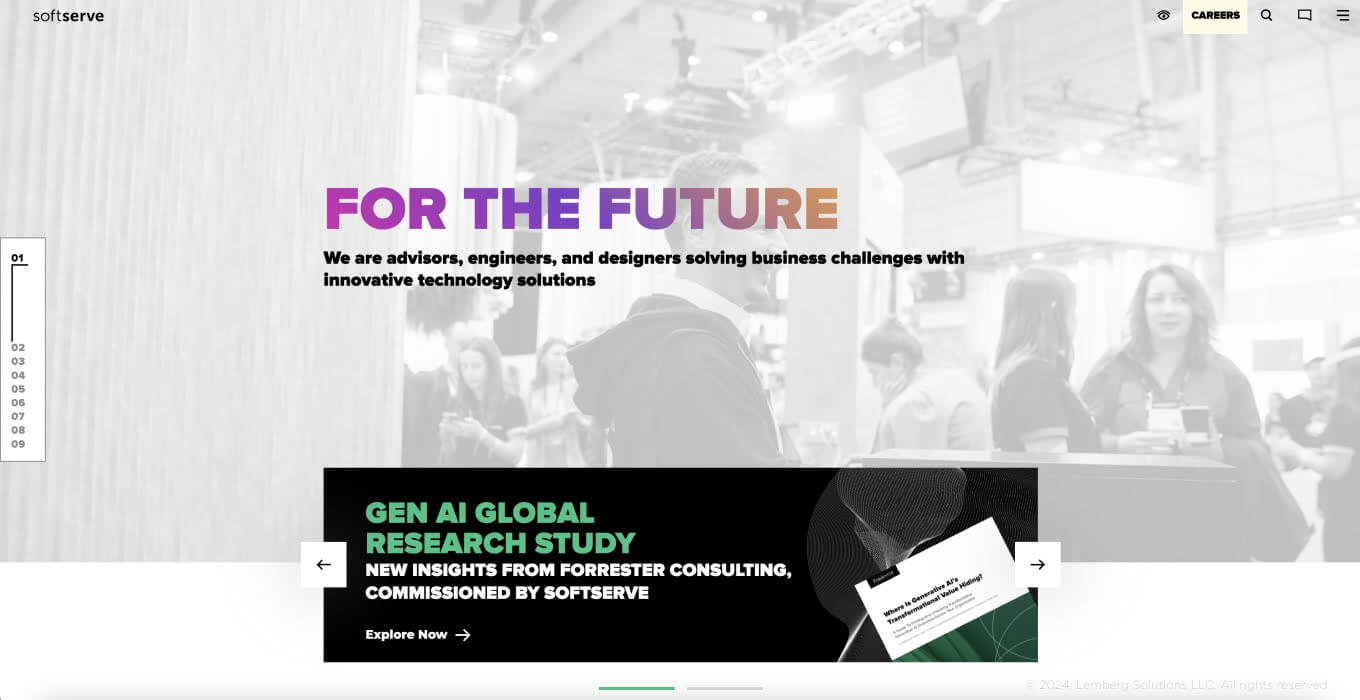

- Founded: 1993
- Employees: 1500+
- Hourly rate: $100 - $149
- Locations: Ukraine, Poland, the UK & offices in the North and South Americas, the Middle East and Southeast Asia
- Key clients: Atlassian, Cisco, Cloudera, IBM
Being in the tech market since 1993, SoftServe has more than 1500 employees in Ukraine and offices in Canada, North and South America, Europe, and the UAE. They help clients to improve their business processes by providing a wide range of services within the healthcare, financial, retail, high-tech, manufacturing, energy, agriculture, and automotive industries. The core SoftServe’s services comprise:
- IoT & robotics
- Cloud & DevOps
- AI & ML
GlobalLogic


- Founded: 2000
- Employees: 1500+
- Hourly rate: $100 - $149
- Locations: Ukraine, the USA, Canada & offices in Western Europe, the Middle East, and South America
- Key clients: Volvo, The Economist, Zappos, Roku
Since 2000, GlobalLogic has grown to more than 1500 employees in Ukrainian offices and many more in Canada, South America, Europe, and the UK. GlobalLogic generates unique solutions in the automotive, banking, communications, retail, healthcare, manufacturing, and other industries. Their services include:
- Software engineering
- Cloud adoption
- Data & analytics
Kindgeek
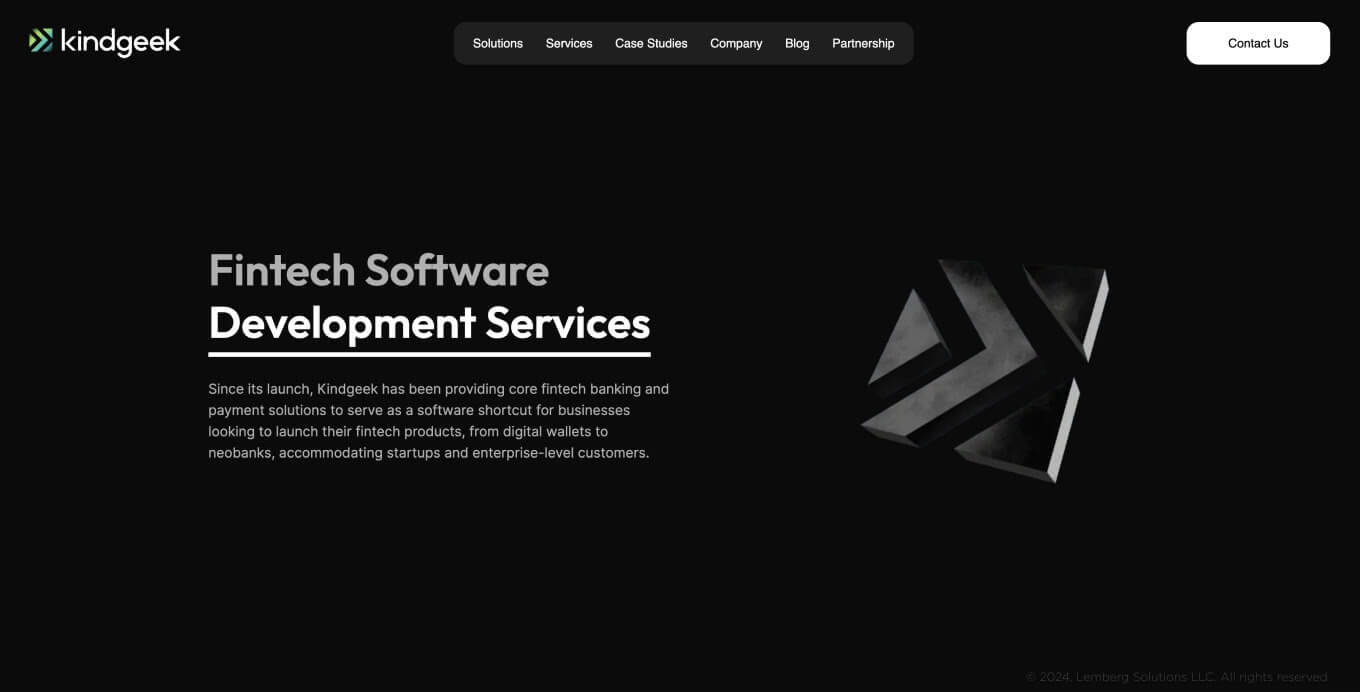

- Founded: 2015
- Employees: 200+
- Hourly rate: $50 - $99
- Locations: Ukraine and the UK
- Key clients: EasyMoney, HyperJar, DECTA, Telefonica
Founded in 2015, Kindgeek has grown to a team of 200+ tech professionals. The company is based in Ukraine and the UK. Their developers specialize in creating solutions for the fintech industry. The company’s services include:
- Web & mobile development
- Business analysis
- UI/UX design
EPAM
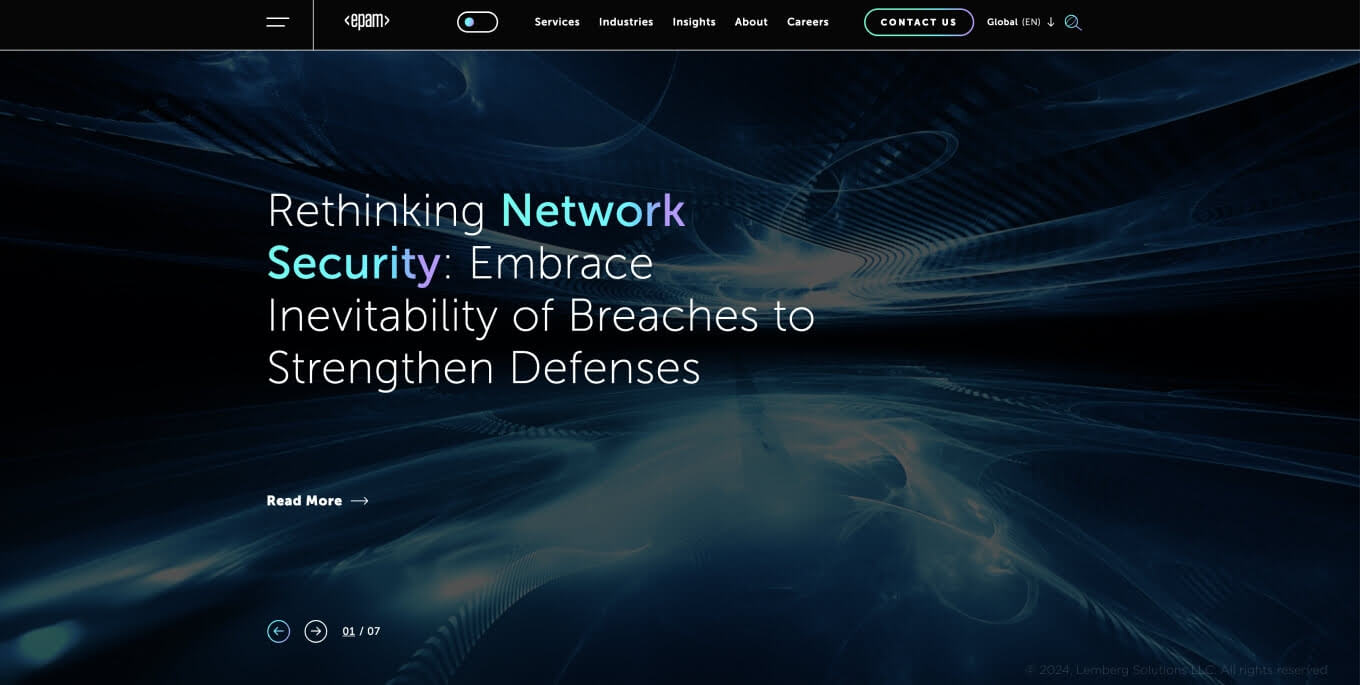

- Founded: 1993
- Employees: 10,000+
- Hourly rate: $150 - $199
- Locations: Ukraine, the UK & offices in the North and South Americas, Western and Central Europe, and the APAC region
- Key clients: WWF, Xsolis, Unity, Digidentity
Since 1993, EPAM has grown to over 14,000 employees across Ukraine. The company also has offices in the USA and provides support for different outsourcing projects in such industries as consumer, healthcare, automotive, insurance, private equity, education, and energy. EPAM offers the following services:
- GenAI & data analytics
- Cloud & DevOps
- Cybersecurity
N-IX


- Founded: 2002
- Employees: 2000+
- Hourly rate: $50 - $99
- Locations: Ukraine, the USA, the UK, Colombia & offices in Western Europe
- Key clients: Bosch, Siemens, eBay, Inditex
First launched as a product startup in 2002, N-IX has matured into a prominent software development company, transforming the tech industry in over 25 countries in Europe and the Americas. With over 2000 professionals, N-IX has proved its tech expertise in various industries, from telecom and fintech to healthcare and agritech. The core company’s services include:
- Software engineering
- Cloud solutions
- AI, ML & data science
TechMagic
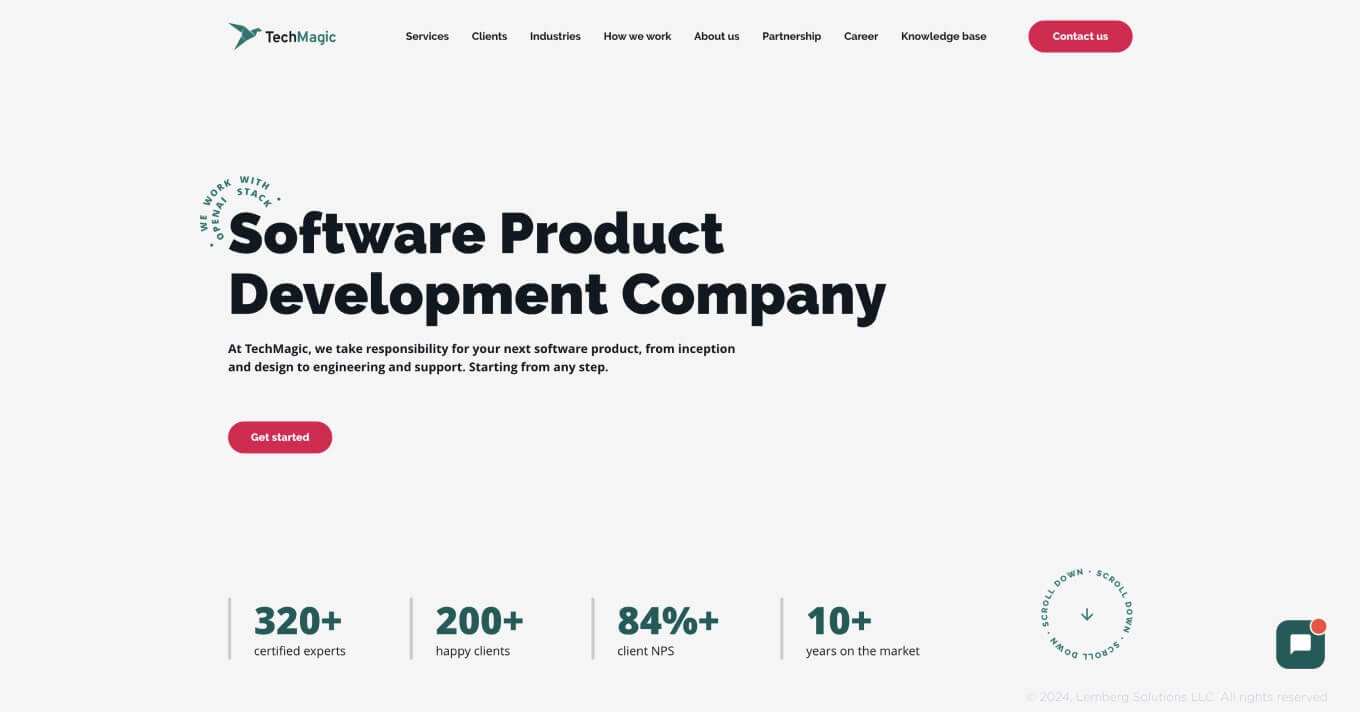

- Founded: 2014
- Employees: 320+
- Hourly rate: $50 - $99
- Locations: Ukraine, the UK and Poland
- Key clients: AnyDesk, Beamery, Tide, TestGorilla
TechMagic is a reliable tech partner for 200+ clients around the globe, providing end-to-end software development services for more than 10 years. The company has over 320 specialists well-versed in developing unique solutions within healthtech, fintech, HR tech, martech domains. TechMagic specializes in:
- Web & mobile development
- Data engineering
- Cloud implementation
Reenbit


- Founded: 2018
- Employees: 60+
- Hourly rate: $25 - $49
- Locations: Ukraine, Canada, and Poland
- Key clients: CloudBooking, Dataloop, Fotopia, DesigneryHealth
Reenbit was founded relatively recently, in 2018, but has already built a strong reputation as a trusted IT solutions provider, with 57 successfully delivered projects. The company has offices in Ukraine, Canada, and Poland. Having 60% of senior staff on the team, Reenbit has solid hands-on experience in:
- Custom software development
- Mobile app development
- Cloud engineering
Edvantis
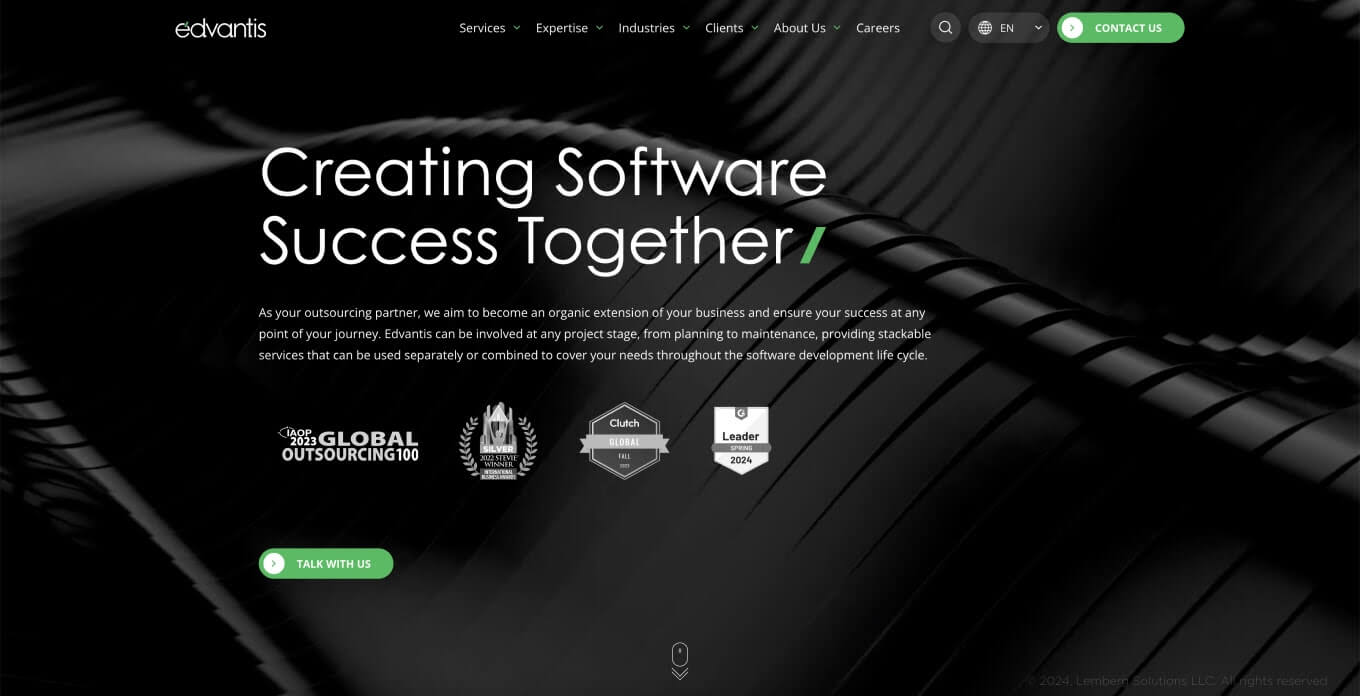

- Founded: 2005
- Employees: 400+
- Hourly rate: $25 - $49
- Locations: Ukraine, the USA, Poland, and Germany
- Key clients: Indeed, Semdatex, TrustRadius, Modulsystem
Since the company’s establishment in 2005, the Edvantis team has significantly scaled up, opening offices all over Europe and the USA. With 18+ years of tech experience and cross-domain expertise, Edvantis has a high level of proficiency in hi-tech, healthtech, real estate, logistics, public sector, and ecommerce. The company focuses on the following services:
- Software engineering
- Data Science, BI & AI
- Cloud development
8allocate
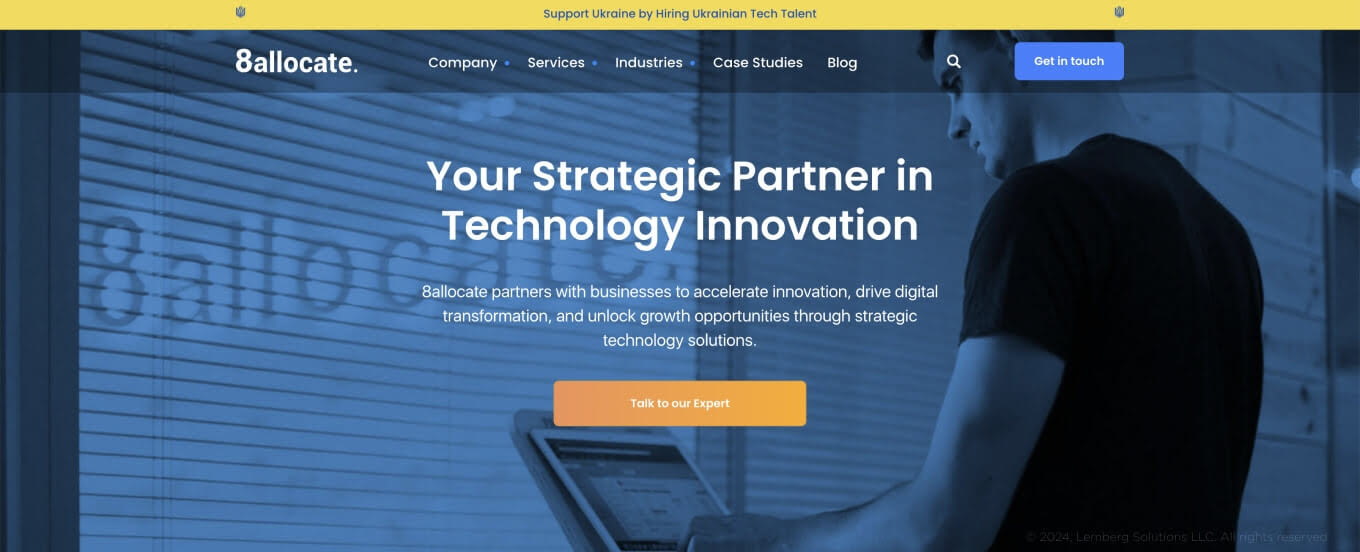

- Founded: 2015
- Employees: 100+
- Hourly rate: $25 - $49
- Locations: Ukraine, Estonia & offices in the CEE region and LATAM
- Key clients: MyHeritage, Airbus, ZALORA, Quincus
8allocate, founded in 2015, has a main office in Tallinn (Estonia) and development centers in Ukraine, Poland, Bulgaria, Romania, and Latin America. The company has over 100 experts who deliver tech products for fintech, edtech, insurtech, logistics, ecommerce, and ESG domains. 8allocate offers a vast range of services, including:
- Digital product development
- AI/ML implementation
- Cybersecurity & risk management
Sombra
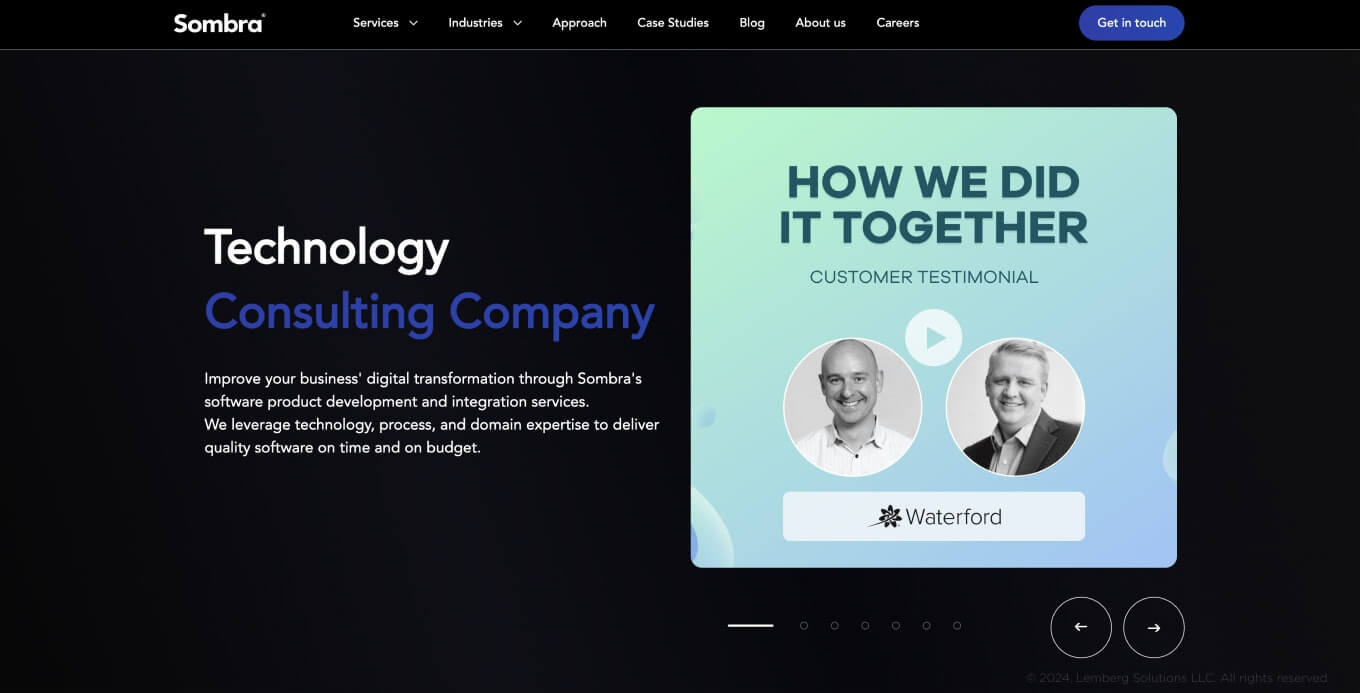

- Founded: 2013
- Employees: 300+
- Hourly rate: $25 - $49
- Locations: Ukraine and Colombia
- Key clients: Wifinity, Blinq, Trusaic, Workrise
Sombra is a technology consulting company, operating since 2013. They are based in Eastern Europe and Latin America, offering software product development and integration services for clients worldwide. The company leverages the expertise of over 300+ tech specialists to provide out-of-the-box solutions in fintech, logistics, telecom, energy, healthcare, and ecommerce domains. Their featured services encompass:
- Software consulting
- Custom software development
- Data engineering
Yalantis
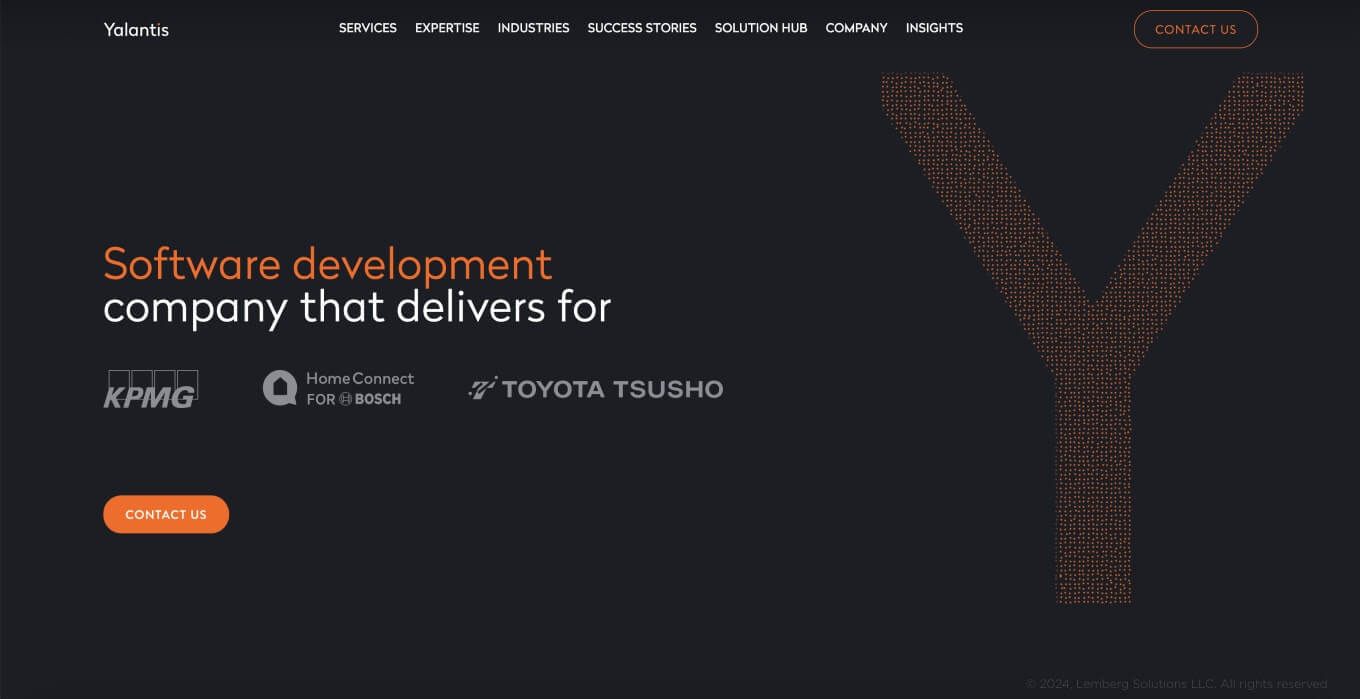

- Founded: 2008
- Employees: 500+
- Hourly rate: $25 - $49
- Locations: Ukraine, Poland, Estonia, Cyprus
- Key clients: KPMG, Stromee, Truhoo, Orbis Systems
With 14+ years of experience, Yalantis is driving the digital transformation of businesses in the supply chain, healthcare, IoT, and fintech niches. They have 500+ experts who work across their development centers in Ukraine, Cyprus, Poland, and Estonia. The company provides such services as:
- Custom software development
- IT consulting
- Digital transformation
Binariks


- Founded: 2014
- Employees: 180+
- Hourly rate: $50 - $99
- Locations: Ukraine, Poland, and the USA
- Key clients: EatStreet, Edulab, MedVisit, Blue Voice Inc
Since 2014, Binariks has offered software engineering and consulting services that adhere to the best standards in the IT industry. The headquarters of Binariks is located in the USA, while development centers are based in Central and Eastern Europe. The company’s specialists, leveraging their in-depth knowledge and tech skills, specialize in the following areas:
- Software product development
- AWS consulting
- Data Science, AI & ML
Noltic
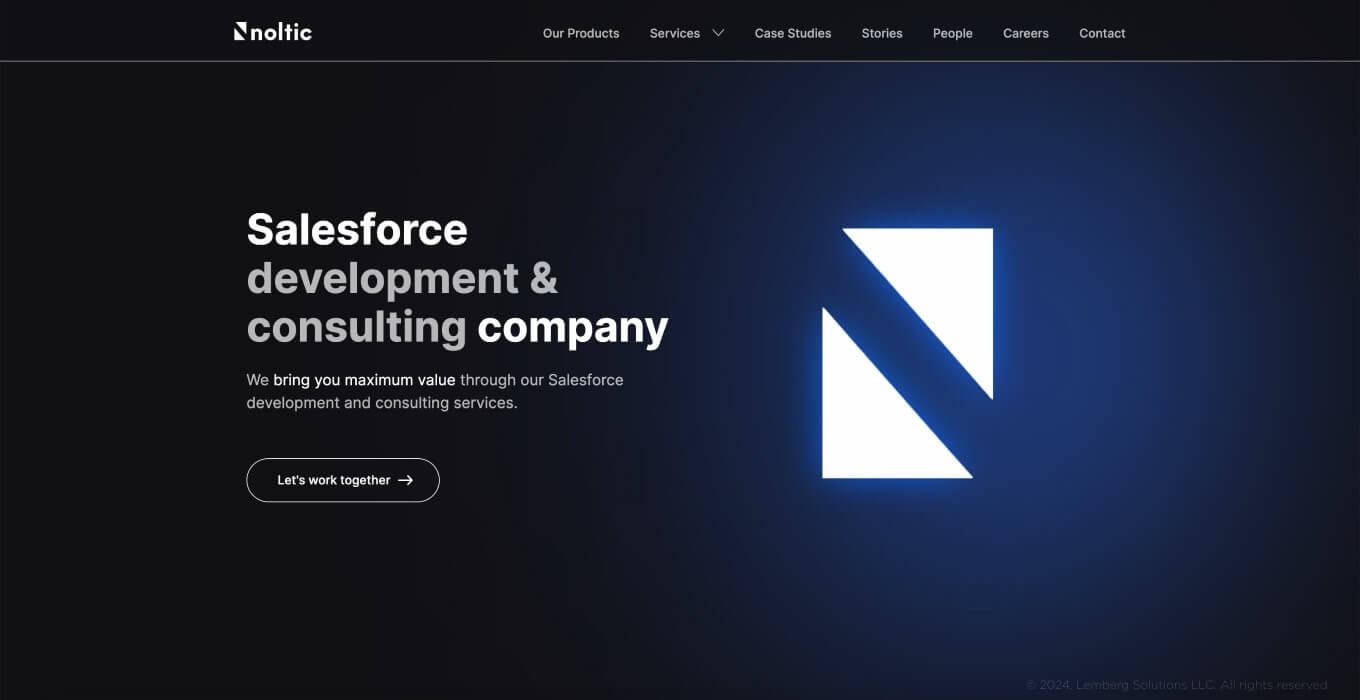

- Founded: 2017
- Employees: 70+
- Hourly rate: $50 - $99
- Locations: Ukraine and Poland
- Key clients: Zenoo, ThirdEye, WABCO, Ideal State
Established in 2017, the Noltic team focuses on delivering Salesforce solutions for companies of all sizes within the insurance, financial, media, logistics, retail, real estate, and education domains. The team of 70+ professionals successfully implemented over 110 projects, demonstrating an exceptional excellence in:
- Salesforce integration
- Salesforce app development
- UI/UX design
Mind Studios
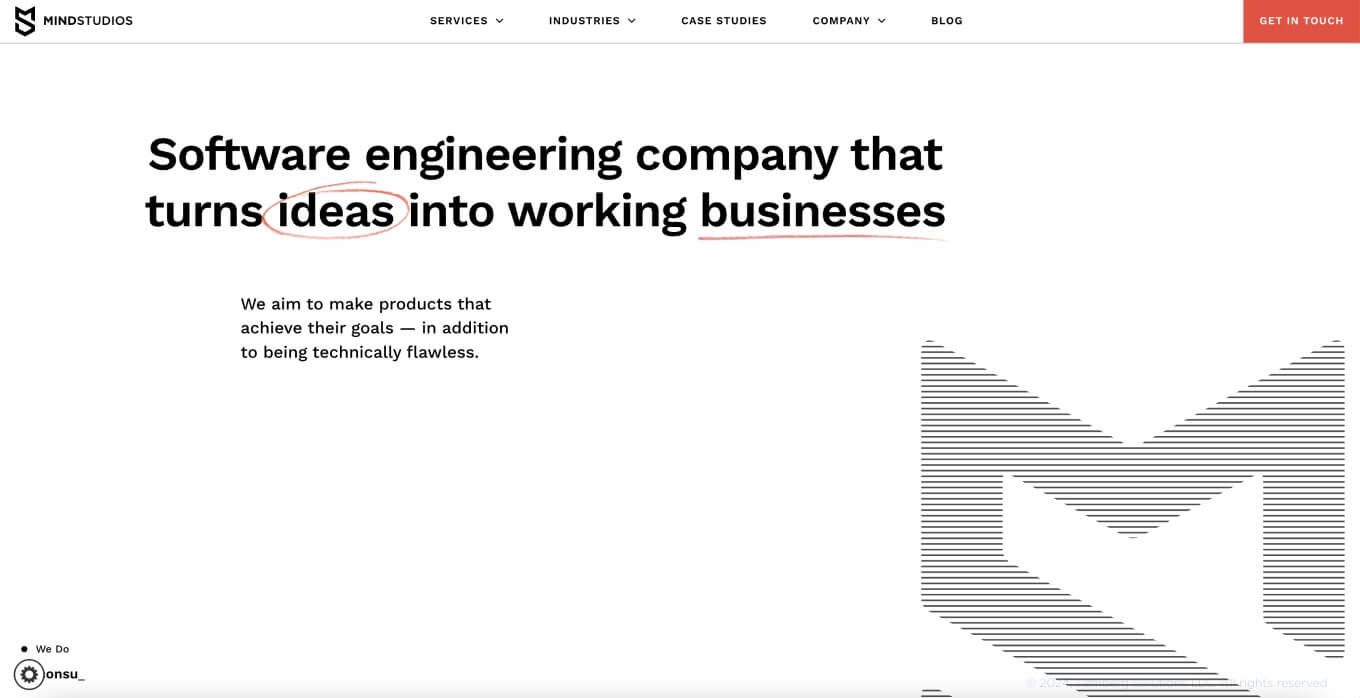

- Founded: 2013
- Employees: 75+
- Hourly rate: $25 - $49
- Locations: Ukraine
- Key clients: HWPO Training, Fitr, UCSF, XMANNA
Mind Studios was launched in 2013 and has grown into a mature software engineering company with 3 offices in Ukraine, the USA, and Austria. Apart from that, they also have built a separate department focusing specifically on game development. With a vetted tech team, Mind Studios helps businesses in the sports, healthcare, real estate, and logistics industries turn their ideas into reality. The primary services of the company are:
- Custom software development
- Software re-engineering
- BA & IT consulting
Avenga


- Founded: 2019
- Employees: 7000+
- Hourly rate: $50 - $99
- Locations: Ukraine, the USA, Poland, Germany, Malaysia
- Key clients: Intel, Kyriba, Clickatell, OLO
Avenga has been a reliable IT outsourcing service provider for over 7 years. The company has representative branches in Ukraine, Poland, Germany, Portugal, Malta, Malaysia, Argentina and the USA. Their team encompasses 7000+ professionals who excel in industries such as pharma and life sciences, automotive, insurance, financial services, and banking. Their core services are:
- Custom software development
- Mobile & web development
- UI/UX
Exoft
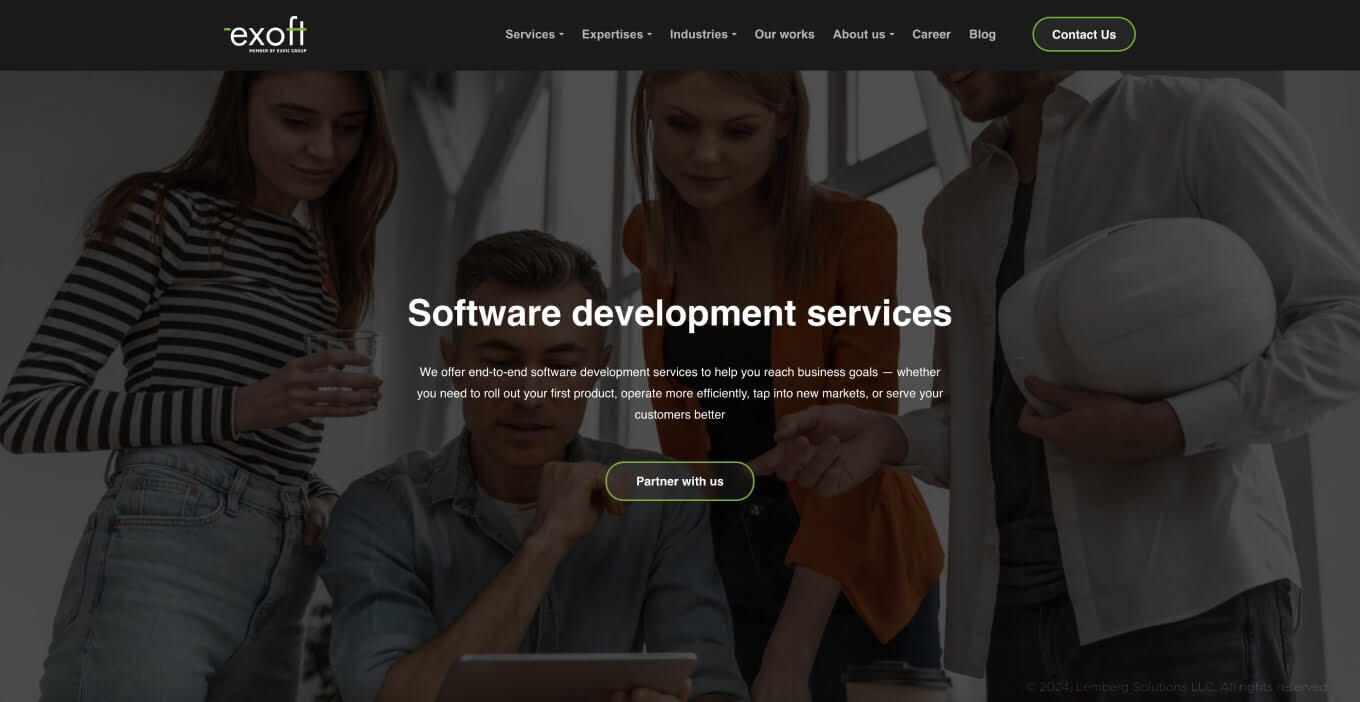

- Founded: 2013
- Employees: 70+
- Hourly rate: $25 - $49
- Locations: Ukraine
- Key clients: InView Analytics, Eloquenti, LogiPlan, ViClinic
Being a top-notch Ukrainian technology solutions provider for 10+ years, Exoft has flawlessly implemented over 500 projects. The company has proven to be a reliable vendor with a 95% customer satisfaction rate for companies in the healthcare, logistics, finance, and construction sectors seeking to enhance their business processes through innovation. Their areas of expertise are:
- Web & mobile development
- UI/UX design
- QA services
Binary Studio
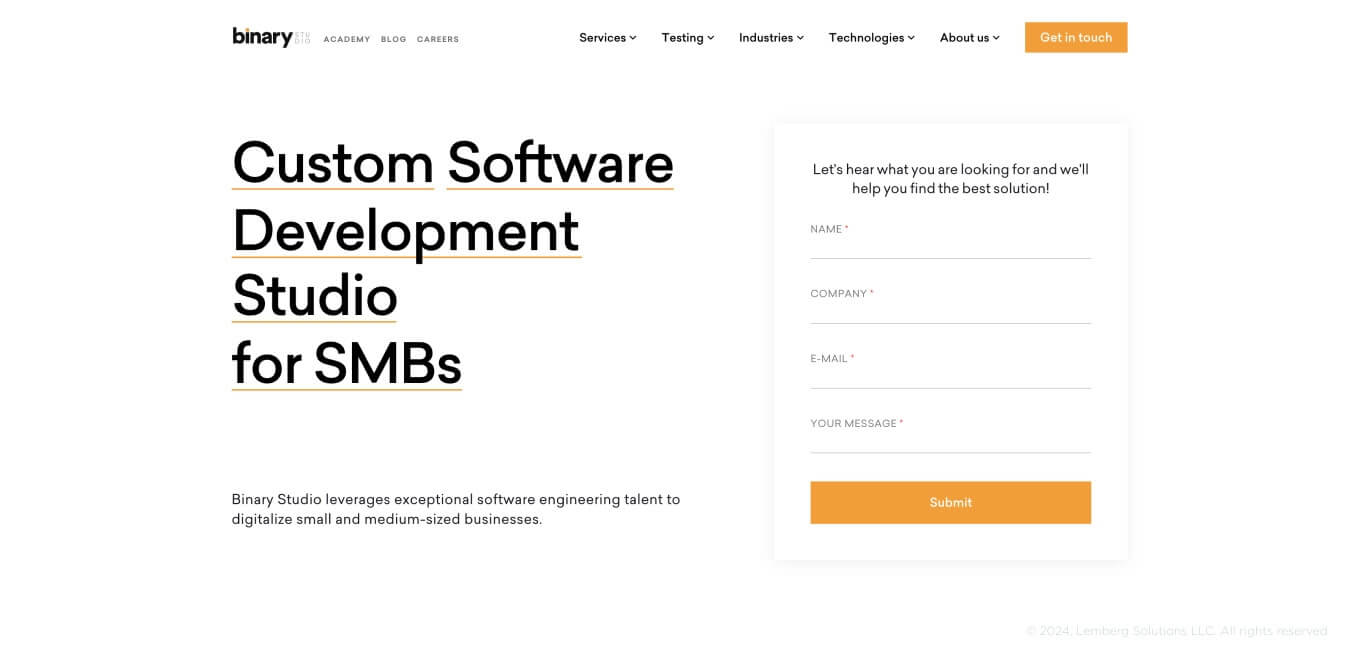

- Founded: 2005
- Employees: 140+
- Hourly rate: $50 - $99
- Locations: Ukraine, the UK and the UAE
- Key clients: SnapCare, Datalogics, PERFORM, Quicket
Starting their company in 2005, Binary Studio managed to expand their business to offices in Ukraine, the UK, and the UAE. Accumulating over 19 years of software engineering experience, Binary Studio has helped many startups and SMEs in the greentech, healthcare, proptech, fintech, and insurance domains to achieve their business goals with custom-made tech products. Their list of services includes:
- MVP software development
- CRM software development
- SaaS app development
Uptech
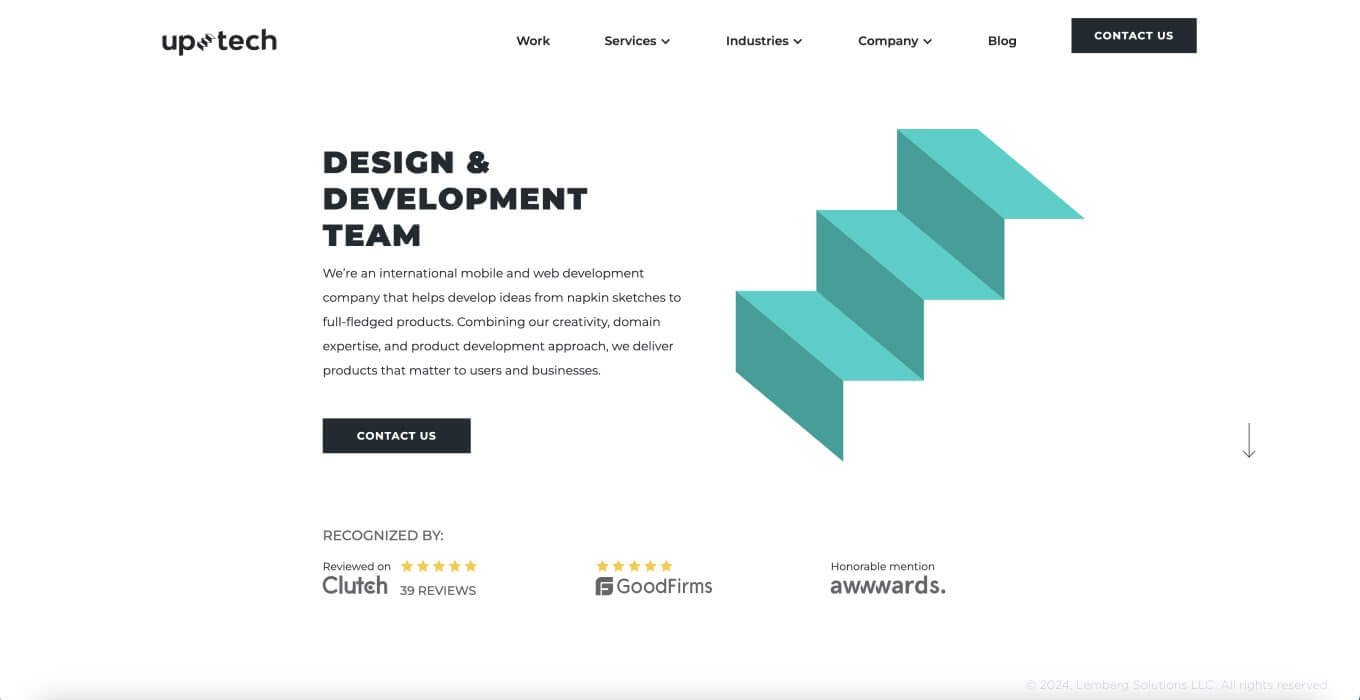

- Founded: 2016
- Employees: 90+
- Hourly rate: $25 - $49
- Locations: Ukraine, Estonia, and Cyprus
- Key clients: Nomad, GOAT, Aspiration, Dollar Shave Club
Since 2016, Uptech has developed 150+ successful products for many businesses featured in the Fortune 500 list. The company comprises 90 highly skilled members on board with extensive expertise in industries such as fintech, proptech, healthcare, social media, retail, ecommerce, and delivery. Uptech helps its clients to gain a competitive edge in the market by providing services such as:
- Web & mobile app development
- GenAI development
- UI/UX design
IT Svit
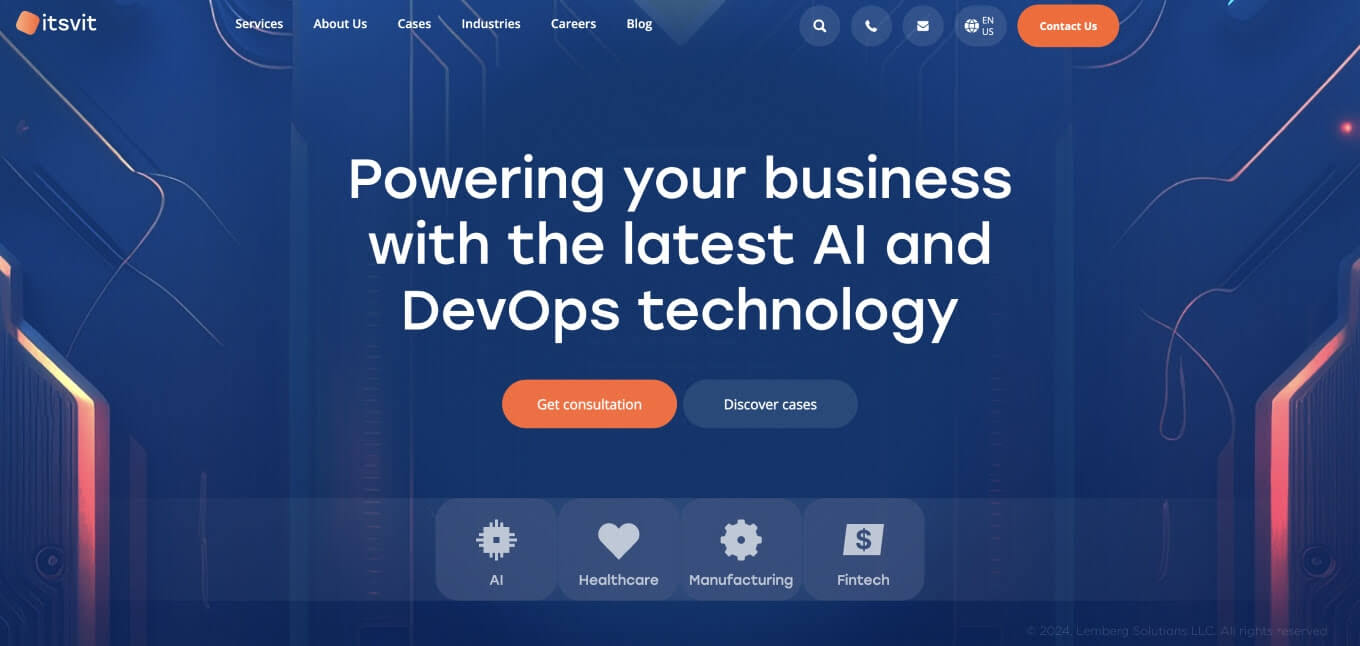

- Founded: 2005
- Employees: 70+
- Hourly rate: $50 - $99
- Locations: Ukraine and Estonia
- Key clients: Staked, Darby, Amcor, SymplyFi
IT Svit has been at the forefront of the IT outsourcing market for 19 years, with headquarters in Estonia and an R&D center in Ukraine. Leveraging the in-depth knowledge of more than 71 experts, they effortlessly level up the digital transformation of the businesses within marketing, banking, delivery, ecommerce, pharmaceutical, telecom, logistics, and energy sectors. The company’s services include:
- DevOps services
- Cloud computing
- Server support
Why outsource to a Ukrainian IT company?
Expanding your business requires constant software improvements since you need to stay ahead of the competition. However, your engineers may lack expertise in specific projects and technologies, or finding the right specialists locally is too challenging. That’s why businesses usually consider outsourcing software engineering to remote specialists with the required skills and knowledge.
While local partners can be an easier option in terms of language and location, they don't always provide sufficient expertise and cost-effectiveness that engineering providers from abroad can offer.
Ukraine has a promising R&D environment with a constantly growing talent pool. Tech giants like Google, Lyft, Oracle, Nvidia, and Samsung have offices in Ukraine, further underscoring the country's potential.
IT services are among the key industries in Ukraine, according to the Ukrainian IT Association. In 2025, the share of telecommunications, computer, and information services in total exports grew from 38.5% to 43% compared to 2024. Numerous successful startups, such as Grammarly, GitLab, People.ai, and Petcube, support the Ukrainian IT market, which encourages software development outsourcing in Ukraine.
According to the International Association of Outsourcing Professionals, numerous Ukrainian IT companies are on the list of “The 2025 Global Outsourcing 100”. The country doesn’t stop innovating and aims to embrace digitalization to the fullest. Ukrainian leaders plan to digitalize further than just government services. They will invest in a digital transformation of the healthcare, education, and financial sectors. This will increase the number of IT experts with practical skills that will be helpful for foreign businesses and contribute to the local economy.
With over 4,000 IT companies and almost 300 thousand tech professionals, Ukraine provides numerous opportunities for businesses to achieve their goals and create high-quality solutions. You can outsource IoT projects, AI development, as well as web and mobile solutions to Ukrainian tech companies that will cover your back.
Don’t worry about the language barrier since Ukraine IT outsourcing organizations require at least an Upper-Intermediate English level from their specialists. Moreover, numerous companies help employees maintain and improve their English skills by offering English courses and regularly checking their knowledge.
Experts forecast Ukrainian IT outsourcing market to experience substantial growth, with an estimated increase of 16.74% from 2023 to 2028, leading to a market volume of approximately US$2.32 billion by 2028.

Choosing the right Ukrainian outsourcing company: what to look for
Selecting a reliable and well-vetted service provider is the key to successful implementation of your idea. With a skilled partner, you can be sure you will get top-tier service and support at all stages of your cooperation. The good news is that there are plenty of service providers in the outsourcing market.
With such an extensive list of top IT companies in Ukraine arises a serious dilemma: choosing the right one who will efficiently cover your needs. We compiled a checklist with the most general requirements to look for when considering an outsourcing provider. Be mindful that this checklist is just a backbone with the most prominent factors to look at, so before starting the search, develop the specific requirements based on your business needs to extend your checklist.

Check the vendor’s expertise
First and foremost, you should look for a company that specializes in services and technologies that match your business requirements. Another overlooked factor is checking whether the company has hands-on experience in your domain to ensure compliance with all industry standards. Usually, you can find all this information on a company's website, or you can book a call to check out the portfolio to be sure that they successfully implemented projects and collaborated with companies similar to yours.
Look into industry recognition
A flawless reputation is an absolute must for your future outsourcing service provider. Any received awards or recognitions are an essential factor that shows the company's active presence in the IT services market and its strive for constant improvement. Look for the list of top leaders in specific services or industries featured on platforms such as Clutch and GoodFirms, or check the company’s website for the presence of any achievements. Such an approach can help you ensure that your partner’s expertise is widely recognized by opinion leaders in the IT sector.
Study their cooperation models
All IT service providers offer different cooperation models, each of which defines a certain degree of involvement of the development team in the process of your project implementation. You should closely study all the available models to understand what kind of agreement suits your project the most, as they have varying outsourcing rates and time frames. For example, if you want to enhance your in-house development team with some niche expertise specialists, it is highly recommended to choose the team extension model. However, if you are in the early stages of digital transformation and are unsure which software architecture will meet your needs or which technologies will be optimal for your product development, you should opt for tech consulting services.
Make sure a robust security compliance is in place
Security compliance is one of the most crucial aspects to look for in your potential IT outsourcing partner. Failure to ensure that your provider follows all security measures and protocols could be critical to your business, compromising the entire infrastructure. The best IT companies in Ukraine leverage internationally recognized cybersecurity standards, complying with ISO 27001, GDPR, HIPAA, and imply data encryption procedures to protect their customers' sensitive data from hackers’ attacks.
Make sure the vendor’s company сulture is a match
Compared to other factors, this one can seem vague. However, no matter how skilled your service provider may be, a lack of open communication flow, shared values, and work attitude could endanger the success of your project. Prior to establishing a partnership, do a background check of service providers: review clients’ testimonials to understand how providers’ teams approach work and cope with different issues. Also, consider requesting a call to understand the provider’s values and work ethic. A successful partnership should be based on transparency and trust, so make sure to invest some time in onboarding your service provider into your work processes, and introducing your values and goals so you can both be on the same page.
How can a Ukrainian IT company help with your project?

Outsourcing a project is a responsible task. However, IT companies in Ukraine have a range of cooperation scenarios that can help you start your outsourcing journey smoothly. Check out the available cooperation models below:
- End-to-end development
Ukrainian software development companies take responsibility for your project from start to finish and ensure you receive a first-rate solution. They establish a constant feedback loop to make sure that every stage of the project leads to the desired results. Whether it’s IoT, AI, or digital experiences field, Ukrainian engineers ensure smooth development and high quality.
- Tech consulting
Ukrainian software developers are known for their strong technical expertise. They excel in software development, system architecture, and IT-related services. Having a versatile skill set, Ukrainian IT experts have hands-on experience with different programming languages, frameworks, and technologies. They have a deep understanding of the latest industry trends and best practices. Besides, they always stay updated with the fast-evolving technology landscape and are well-versed in emerging technologies like sensor fusion and computer vision. Ukrainian software outsourcing professionals are known for their problem-solving skills. They can consult you on complex technical challenges, offer innovative solutions, and optimize existing processes.
- Solution discovery
If you have a technical idea but don’t know where to begin and how to implement it, Ukrainian tech vendors will help you with a discovery service. They will check the technical feasibility of your project, come up with a solution architecture, offer the most suitable tech stack, and provide a detailed project estimate. Discovery with Ukrainian experts will help you move to the next stages of your product development effortlessly.
- Team extension
If your internal team lacks expertise in specific technical areas or you’re experiencing a local tech talent shortage, Ukrainian IT experts will gladly join and help you resolve your technical challenges. You can partner with a dedicated development team in Ukraine to get expert knowledge in embedded engineering, software development, ML development, or any other specializations you may require.
- Support & maintenance
Get comprehensive support for your solution at each stage of your collaboration with software developers in Ukraine. They will audit your website, mobile app, and embedded system, track any vulnerabilities, solve security issues, and implement needed updates. Ukrainian data science specialists will check and improve the accuracy of your ML model.
By choosing software development in Ukraine, you’ll get to choose different types of services, including end-to-end product development, tech consulting, discovery, team extension, and support and maintenance. Depending on your needs, Ukrainian experts will extend your technical expertise and take on complex challenges.
How to cooperate with an external team
Typically, Ukraine IT outsourcing companies offer two options: short-term project-based collaboration and long-term commitment with a dedicated team. The best way to cooperate with your partner’s team is to start with short-term cooperation and proceed with long-term engagement once you know how they work and can trust them.
Upon successful project execution and delivery, you gain insights into the quality of your partner’s work. If the performance aligns with your criteria, you can go for a long-term cooperation, which involves the establishment of a dedicated team.
For a successful collaboration with Ukrainian IT outsourcing companies, consider the following tips:
- Evaluate the technical and communication skills of an external team.
Technical excellence is paramount; however, effective personal interaction and engagement play a key role since you will frequently interact with the team.
- Communicate your intentions to scale your team on the early stages of project development.
Outstanding experts are often busy with existing commitments, meaning that your tech partner needs time to manage the team properly.
- Hire a project manager, either a local one or from your partner’s side.
Their expertise and industry knowledge will define the efficiency of the entire team.
- Treat your remote team as if it was your in-house team.
Make sure that you follow your corporate values and communicate them with your team. Always provide feedback and consider your team’s recommendations and concerns.
Proper communication with an external team and preliminary assessment of their technical skills will help you choose a partner for short- and long-term commitment. Outsource software development to companies in Ukraine and follow our tips to establish strong cooperation with them.

Final thoughts
Software development companies in Ukraine have established themselves as global IT outsourcing hubs due to the professionalism and skills diversity of Ukrainian tech teams. With the help of highly skilled and well-educated tech specialists, businesses can get unique and high-quality software products. Ukrainian developers are proficient in English, which makes communication and collaboration easy. Besides, since Ukrainian outsourcing companies are culturally aligned with Western businesses, there will be fewer gaps in understanding, work ethic, and business standards. Many global corporations have successfully outsourced projects to Ukrainian IT companies, which proves their reliability and competence.
If you need to create an end-to-end solution, receive a professional consultation, or extend your team, simply drop us a line and we’ll get back to you shortly with all the answers.
FAQs
What is the cost-benefit of outsourcing software development in Ukraine?
Ukrainian IT outsourcing companies offer a strong cost-to-quality ratio. While hourly rates typically start at $25–$50, which is significantly lower than in the EU or US market, they still provide access to highly skilled and experienced professionals. This makes Ukraine an attractive destination for businesses looking to reduce development costs without compromising on expertise or project quality.
Is it safe to outsource software development to Ukraine in 2025?
Yes. Ukraine’s IT industry has proven highly resilient. Most outsourcing companies have reliable business continuity plans, cloud-based infrastructure, and relocated teams to ensure uninterrupted delivery.
How do I choose the best IT outsourcing development companies in Ukraine?
First, clearly define your project requirements and team needs. Then look for companies with proven expertise in your domain, consider their portfolios, experience, and client reviews. Finally, evaluate their processes, collaboration models, and cost-effectiveness, and choose the one that suits you best.
Do Ukrainian tech companies have experience working with global clients?
Absolutely. Ukrainian tech companies have extensive experience collaborating with international clients, including both startups and Fortune 500 enterprises. They are known for delivering software solutions to markets in the U.S., Europe, Israel, and beyond.





